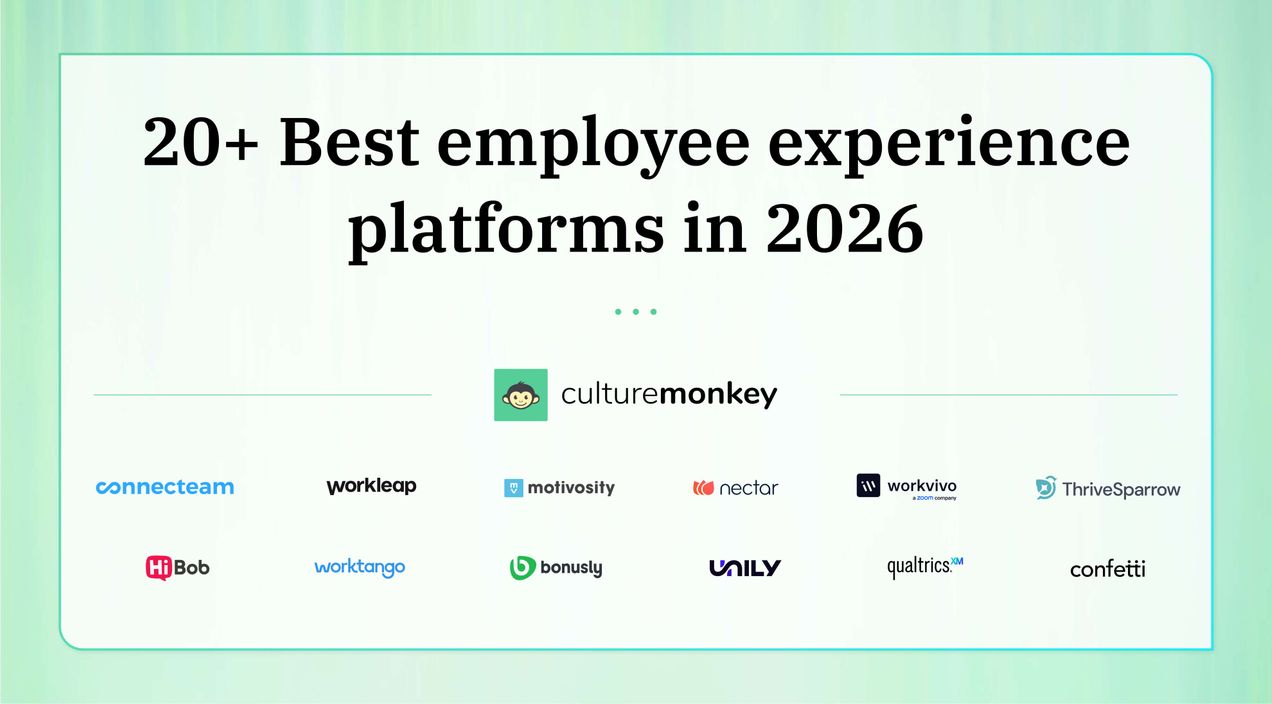Employee experience strategy: How to build a people-first workplace in 2025

Remember those classic video games where each level pulled you in deeper? The pacing, the music, the hidden power-ups, it all felt natural. But behind that magic was a strategy. Every moment was intentionally designed to guide, challenge, and reward you.
Now imagine Level 4 had no logic. Dead ends everywhere, zero checkpoints, and a boss fight that showed up out of nowhere. You’d quit. Anyone would.
That’s exactly what happens in companies without a clear employee experience strategy.
You can’t expect people to stay engaged if their journey feels random. From onboarding to growth, every stage of the employee life cycle should feel like it was built for them, not just slapped together.
In this blog, we’ll show you how to stop freestyling EX and start designing employee engagement like the best games: intuitive, motivating, and impossible to walk away from.
TL;DR
What is employee experience?

TL;DR
Employee experience is the entire journey an employee has within a company, shaped by culture, leadership, communication, and tools. It focuses on designing meaningful interactions that foster growth, belonging, and satisfaction, ultimately boosting engagement and retention.
Employee experience refers to the complete employee life cycle an employee has within an organization—from their first interaction as a candidate to their last day and even beyond. It includes every touchpoint, system, conversation, and environment that shapes how employees feel about their work and workplace.
A strong employee experience strategy goes beyond perks or engagement programs; it’s about intentionally designing employee engagement that support growth, belonging, and satisfaction. This experience is shaped by various components—company culture, leadership, communication, digital tools, physical workspace, and HR processes.
When organizations invest in building an exceptional employee experience, they often see improvements in engagement, employee retention, productivity, customer satisfaction and even employer branding.
Today, leading companies use data, feedback, and tools like employee experience indexes and EX software platforms to measure and enhance this journey continuously. Ultimately, a well-crafted employee experience isn’t just about making work better—it’s about making employees feel valued, heard, and empowered every step of the way.
What determines employee experience?

Employee experience is shaped by every interaction an individual has within the organization—from their physical environment to how they’re recognized and developed. Great employee engagement isn’t built on perks alone; an employee's life cycle is the result of intentional design across key areas that influence how employees feel, perform, and grow.
Here are the essential components that determine a meaningful employee experience:
- Physical environment: A thoughtfully designed workspace—featuring ergonomic setups, natural lighting, and collaborative zones—enhances comfort, focus, and creativity in the workplace.
- Company culture and values: A strong culture rooted in trust, recognition, and respect helps employees connect with your mission and feel a genuine sense of belonging.
- Growth and development: Providing upskilling opportunities, professional development mentorship, and clear career paths shows that employee development is a core part of your employee experience strategy.
- Work-life balance: Flexible schedules and policies that support personal well-being contribute to a more holistic employee experience and reduce burnout.
- Effective communication: Open dialogue, regular feedback, and inclusive decision-making foster engagement and reinforce your employee experience framework.
- Employee experience management: Proactive efforts to monitor and enhance experiences through feedback tools, KPIs, and initiatives help ensure the strategy stays relevant and people-centric.
- Employee experience initiatives: Structured programs—such as onboarding revamps or wellness offerings—create consistent, positive moments that matter throughout the employee lifecycle.
What does a long-term employee experience roadmap look like?
A long-term employee experience roadmap is a strategic blueprint that outlines how an organization plans to design, enhance, and sustain a meaningful employee life cycle over time. It's not a one-off initiative—it’s a continuous, evolving process that aligns with both employee needs and business goals.
- Establish a clear employee experience definition: Start by defining what employee engagement means for your organization and aligning it with your values and employee proposition.
- Audit the current state: Use employee experience surveys, feedback tools, and employee experience KPIs to assess what's working, what's broken, and where experience gaps exist.
- Set strategic priorities by stage: Break and build employee experience roadmaps into phases—activation, optimization, and enhancement—with clear objectives tied to each employee lifecycle stage.
- Create an employee experience activation plan: In the early phase of the onboarding process, focus on building awareness, training managers, and launching key employee experience initiatives.
- Enhance through data and feedback: Use insights from EX software platforms and continuous listening tools to drive experience improvement and personalization.
- Incorporate workplace experience strategy: Don’t ignore the physical and digital work environment—this should evolve alongside your employee experience framework.
- Evolve the strategy with best practices: Refine your approach based on employee experience best practices and emerging needs, using internal data and external benchmarks.
- Measure success and refine regularly: Track employee experience index scores and tie them to outcomes like retention, engagement, and culture health. Use these insights to iterate the roadmap annually.
What is an employee experience strategy?

An employee experience strategy is more than a feel-good initiative—it’s a structured, long-term approach to designing how employees interact with every aspect of your organization. It turns everyday moments into meaningful experiences by aligning people-first practices with company goals. A strong strategy not only improves engagement but also boosts retention, productivity, employee life cycle and overall workplace culture.
Here’s what makes up a well-rounded, positive employee experience strategy to analyze everything from employee engagement to employee experience:
TL;DR
An employee experience strategy is a structured, long-term plan that designs how employees interact with every part of an organization. It aligns people-first practices with company goals to create consistent, positive moments throughout the employee lifecycle.
This strategy involves leadership support, data-driven improvements, workplace optimization, and activating initiatives that boost engagement, retention, and overall culture.
- Intentional design across the employee lifecycle: From the onboarding process to exit, the strategy outlines how to create positive, consistent moments at every stage of the employee journey.
- Alignment with company values and goals: It ensures that employee engagement programs are rooted in the organization's purpose, vision, and employee proposition—bridging the gap between culture and operations.
- Employee experience management: Ongoing efforts to measure and improve experiences using feedback loops, employee experience KPIs, and EX software platforms are central to the strategy.
- Integration of workplace experience strategy: Improving employee experience includes optimizing both physical and digital workspaces to support productivity and well-being.
- Activation of employee experience initiatives: The strategy brings ideas to life through structured programs that improve communication, development, recognition, and inclusion.
- Use of data and measurement tools: Employee experience indexes, pulse surveys, and sentiment analysis guide data-backed decisions and continuous improvement.
- Leadership and cross-functional involvement: A successful employee experience meaning isn't siloed in HR—it’s championed by leadership, workplace experience managers and supported across departments.
What are the 7 stages of employee experience?

The employee experience doesn’t begin on day one or end with a resignation letter. It’s a continuous journey that spans the entire lifecycle—from the first impression of your brand to the final goodbye. A well-defined, positive employee experience strategy ensures each of these stages is thoughtfully designed to build trust, engagement, and long-term advocacy.
Here are the seven key stages of the employee experience:
- Attraction: This stage focuses on building a strong employer brand through your employee proposition, company culture, and workplace values to draw in the right candidates.
- Recruitment and onboarding: A smooth and structured onboarding process—with tools like onboarding templates and clear communication—helps new hires feel connected, supported, and aligned with the company from day one.
- Engagement: At this stage, the focus shifts to building employee engagement through recognition programs, open feedback loops, and opportunities that align with both personal goals and the broader employee experience framework.
- Development and learning: Providing continuous learning opportunities, mentoring, and professional development growth paths supports long-term retention and strengthens your employee experience management efforts.
- Well-being: This stage prioritizes holistic employee well-being, incorporating work-life balance policies, mental health support, wellness initiatives, and a people-first HR strategy.
- Rewards and recognition: Structured rewards systems and recognition initiatives reinforce employee contributions, driving motivation and reinforcing a positive workplace experience strategy.
- Offboarding: A thoughtful offboarding process—complete with exit interviews, knowledge transfer, and alumni engagement—ensures the final stage of the journey is respectful and relationship-driven.
How to implement a successful employee experience strategy?

Some people might wonder, “How to create a great employee experience?”. Well, creating meaningful employee experience and culture doesn’t happen by accident—it requires intentional design, leadership support, and a commitment to continuous improvement. A successful employee experience strategy aligns your people priorities with business goals, ensuring that every stage of the employee journey is consistent, engaging, and measurable.
Here’s how to implement it effectively:
TL;DR
To implement a successful employee experience strategy, set clear SMART goals aligned with business outcomes and gather employee feedback to identify needs. Design a holistic approach covering all lifecycle stages, empowering leaders to champion the strategy and fostering open communication.
Continuously measure progress using KPIs, prioritize employee well-being, and adapt the strategy regularly to ensure lasting engagement and improvement.
- Define clear objectives using SMART goals: Start with Specific, Measurable, Achievable, Relevant, and Time-bound (SMART) goals that align with your overall business outcomes. Use employee journey maps to plan this out across key milestones.
- Conduct employee feedback and assessment: Gather insights through employee experience surveys, interviews, and EX software platforms. Use this data to identify friction points and shape employee experience initiatives that address real needs.
- Align with organizational values: Ensure the strategy reflects your employee proposition, culture, and values. Consistency between what you preach and what employees experience builds trust and authenticity.
- Design a holistic approach: Cover every stage of the employee lifecycle—from attraction and onboarding to offboarding. Integrate your workplace experience strategy to ensure both physical and digital environments support engagement.
- Empower leaders and managers: Train leadership to model employee experience best practices. Their involvement is critical to successful employee experience activation across departments.
- Foster collaboration and communication: Build a culture of transparency through collaboration, professional development, strong communication channels and knowledge-sharing tools. This strengthens both engagement and trust in the company culture.
- Prioritize employee well-being: Embed wellness programs, mental health support, and flexible work policies into your strategy. These are essential components of a holistic employee experience.
- Continuously measure and adjust: Use employee experience KPIs to track satisfaction, retention, and engagement. Let data guide decisions and support employee experience enhancement over time.
- Foster a culture of continuous improvement: Encourage feedback loops, revisit the strategy regularly, and refine based on what’s working—and what’s not.
What role does leadership play in shaping employee experience?
Leadership is one of the most influential drivers of a successful employee experience strategy. From setting the tone to shaping culture, the actions and mindset of business leaders directly impact how engaged employees perceive their journey within the organization.
- Sets the cultural tone: Leaders are the embodiment of company culture and employee proposition. Their behavior signals what’s valued and what’s not.
- Drives the employee experience strategy: Without leadership buy-in, even the best strategies remain ideas. Leaders align people-first HR strategy with business goals and allocate resources to support EX initiatives.
- Influences trust and engagement: Transparent, empathetic leadership fosters psychological safety and strengthens the link between employee engagement and culture.
- Leads experience activation: Leaders champion employee experience activation plans, ensuring that vision translates into real-world improvements across departments.
- Models best practices: Great leaders follow employee experience best practices themselves—through active listening, inclusive decision-making, and meaningful employee recognition.
- Supports continuous enhancement: Leaders who prioritize feedback loops and performance data enable ongoing employee experience enhancement across the organization.
- Connects experience with outcomes: Strategic leaders use employee experience KPIs and employee experience indexes to guide and refine decisions.
How to align your EX strategy with business outcomes
Aligning your employee experience strategy with business outcomes is essential for making EX a value driver, not just a feel-good initiative. When done right, EX doesn’t just align workplace culture and employee experience; it fuels performance, retention, innovation, and culture, all of which impact the bottom line.
- Start with clear business objectives: Define what success looks like—whether it’s reducing turnover, improving customer satisfaction, or accelerating innovation. Your employee experience strategy should support these goals directly.
- Map the components of employee experience to impact areas: Connect touchpoints like onboarding, performance reviews, and workplace experience strategy to measurable business outcomes like time-to-productivity or NPS.
- Use employee experience KPIs: Track leading indicators like engagement, sentiment, and EX index scores to predict downstream results such as retention, performance, and culture alignment.
- Involve leadership from day one: Make sure leaders don’t just approve the strategy but actively support and embody it. Leadership alignment signals EX as a business priority.
- Leverage data from EX software platforms: Use analytics to tie employee experience initiatives to business metrics, proving ROI and guiding future investments.
- Build a feedback loop into your strategy: Regular input from engaged employees ensures your EX strategy evolves with business needs and workplace dynamics.
- Create an employee experience playbook: Standardizing best practices across departments helps scale what works and ensures consistency, especially during periods of growth or change.
Employee experience strategy examples

An effective employee experience strategy isn’t just a theoretical framework—it’s brought to life through real, practical initiatives that impact how employees feel, grow, and engage every day. The most successful strategies are those that blend culture, communication, recognition, and development into consistent, meaningful experiences across the employee lifecycle and create happy employees in comparison to other companies, thus having a competitive advantage.
Here are a few high-impact examples:
- Employee development initiatives: Offer learning paths, mentorship, and training programs to support career growth, business success and reinforce your employee experience framework.
- Recognition and rewards programs: Use peer recognition platforms, employee-of-the-month awards, and performance-based bonuses to boost morale and engagement.
- Communication and feedback channels: Implement surveys, suggestion boxes, and open forums to promote transparency and strengthen employee experience management.
- Collaborative and inclusive culture: Encourage teamwork and belonging through employee resource groups, cross-functional projects, and inclusion initiatives that align with your workplace experience strategy.
- Digital employee experience tools: Adopt EX software platforms to personalize touchpoints, streamline onboarding, and enable continuous feedback throughout the employee journey.
Common mistakes in implementing an employee experience strategy

Even with the best intentions, organizations often stumble when putting their employee experience strategy into action. A successful approach requires more than launching initiatives—it demands alignment, consistency, and continuous learning. Missteps in planning or execution can undermine even the most well-designed employee experience framework.
Here are some common mistakes to avoid:
TL;DR
Common mistakes in implementing an employee experience strategy include lacking leadership support, ignoring employee feedback, and inconsistent execution across teams. Without clear measurement and adaptation, strategies can quickly lose effectiveness.
Additionally, neglecting continuous improvement and operating without structured documentation lead to misalignment and fragmented experiences, undermining the overall success of the employee experience framework.
- Lack of leadership support: Without visible commitment from leadership, even the strongest employee experience activation plan can lose momentum. Leaders must actively champion and model the behaviors behind the strategy.
- Inadequate employee involvement: Excluding employees from planning or overlooking their feedback can result in a disconnect between initiatives and real needs—impacting the relevance of your employee experience strategy roadmap.
- Inconsistent implementation: Uneven rollout across departments or regions can create disparities in the employee experience in the workplace, making it feel fragmented rather than unified.
- Failure to measure and adapt: Not using employee experience KPIs or tracking progress through feedback tools can limit your ability to improve employee experience examples or course-correct initiatives based on data.
- Neglecting continuous improvement: A static strategy won’t keep pace with employee expectations. Embedding a culture of continuous feedback and learning is essential to building an employee experience strategy that evolves over time.
- Lack of structured documentation: Operating without a clear employee experience playbook or strategy template often leads to ad-hoc decisions, misalignment, and inconsistency in delivery.
Employee experience best practices to follow

A truly effective employee experience strategy isn’t built overnight—it’s designed through consistent actions, smart planning, and human-centric thinking. The best organizations treat employee experience as a strategic function, not a reactive fix. From daily interactions to long-term development, each moment in the employee journey is an opportunity to build trust, culture, and performance.
Here are some best practices for employee experience to embed into your strategy to provide an exceptional employee experience:
Culture and connection
Fostering belonging, trust, and alignment with company values.
- Prioritize employee voice: Actively listen through feedback tools, surveys, and open dialogue to ensure employees feel heard and respected.
- Foster a positive work environment: Build a company culture rooted in collaboration, inclusivity, and psychological safety.
- Make recognition a habit: Encourage consistent appreciation through peer recognition platforms and leadership acknowledgment.
- Champion cross-functional collaboration: Bridge HR, IT, and operations to deliver a unified employee experience strategy roadmap.
- Align with values and proposition: Ensure every EX initiative reflects the company’s mission, values, and employee proposition.
Growth and development
Enabling professional progress and long-term engagement.
- Provide growth opportunities: Offer mentorship, career pathways, and upskilling programs that align with employee career goals.
- Create tailored experiences: Personalize development plans based on individual goals, learning styles, or roles.
- Support employee development initiatives: Embed learning and professional development opportunities into your employee experience framework through structured training programs and coaching.
Operational excellence
Designing frictionless, efficient, and meaningful daily experiences.
- Streamline employee processes: Use digital tools and workflows to remove barriers and increase productivity.
- Integrate EX tools with purpose: Adopt EX software platforms that improve daily workflows and support the digital employee experience strategy.
- Develop an employee experience activation plan: Ensure that strategic ideas are mapped to clear actions, timelines, and owners.
- Avoid confusion with clear documentation: Use assets like an employee experience playbook, strategy template, or internal PDF to align teams and execution instead of regular employee engagement surveys.
- Design from the employee’s perspective: Map the full lifecycle journey—from onboarding to offboarding—with empathy and clarity.
Feedback and optimization
Measuring impact and evolving with employee needs.
- Continuously measure and improve: Use employee experience KPIs, engagement scores, and sentiment analysis to track effectiveness.
- Conduct regular feedback loops: Gather input at every stage of the lifecycle to surface friction points and improvement areas.
- Adapt and scale what works: Use data from experience surveys to refine and evolve the employee experience strategy over time.
- Build for continuous improvement: Make improvement part of your culture by consistently testing, learning, and iterating career development opportunities.
How technology (like EX platforms) supports seamless employee experiences
In today’s hybrid and digitally connected workplaces, technology is the backbone of a modern employee experience strategy. EX (employee experience) platforms and digital tools streamline communication, automate processes, and personalize the employee journey—making it smoother, smarter, and more human.
- Centralizes the employee experience framework: EX platforms bring together onboarding, feedback, learning, and employee recognition into a unified system, aligning with your overall employee experience roadmap.
- Enables real-time feedback: With pulse surveys and sentiment tracking, these tools support continuous employee experience measurement—helping managers act fast and smart and enhance employee productivity.
- Improves digital workplace experience: By integrating communication, collaboration, and productivity tools, EX software ensures the digital employee experience is frictionless.
- Supports data-driven decisions: Built-in analytics help HR and leadership track employee concerns, employee experience KPIs, identify trends, and adapt initiatives proactively to foster a positive workplace culture.
- Drives employee experience enhancement: From automating routine tasks to customizing development plans, technology reduces noise and lets engaged employees focus on meaningful work.
- Fuels strategy activation: Tools make it easier to implement your employee experience activation plan at scale—with consistency across teams and geographies.
How can an employee experience platform help you implement a positive employee experience strategy?

An employee experience platform is a technology solution designed to enhance and streamline various aspects of the employee experience. These digital tools provide the structure and support needed to turn your employee experience strategy from a concept into a consistent, scalable reality. It can assist in implementing an employee experience strategy by:
- Centralizing communication: A unified hub ensures transparent, timely updates and connects engaged employees across departments, strengthening employee experience in the workplace.
- Enabling collaboration: Features like project boards, shared documents, and real-time chat promote teamwork and reinforce a connected, collaborative culture.
- Supporting feedback and recognition: Most platforms include tools for employee feedback, pulse surveys, and recognition, the key components of employee experience enhancement and engagement.
- Automating workflows: Routine processes like leave approvals, performance reviews, or onboarding can be automated to improve efficiency and free up time for meaningful work.
- Offering learning and development resources: Many EX platforms integrate learning modules and training paths to support continuous growth, career development, and internal mobility.
- Providing data analytics and insights: Built-in dashboards help track employee experience KPIs, engagement scores, and performance trends—enabling smarter, data-driven decisions.
- Aligning with digital employee experience strategy: These tools bridge remote, hybrid, and in-office environments, by ensuring a cohesive and consistent employee journey across all touchpoints.
- Supporting employee experience management: Centralized oversight allows HR teams to align initiatives with organizational goals, ensuring the experience remains people-first and performance-driven.
Summary
Conclusion
Implementing an effective employee experience strategy requires prioritizing employee well-being, fostering a positive work environment, and providing opportunities for growth and development.
Leveraging an employee experience platform can streamline communication, collaboration, feedback, and recognition processes, enhancing the overall employee experience. By following best practices and leveraging the right tools, organizations can create a thriving and engaged workforce that contributes to their success.
Ready to enhance employee experience strategy? Explore the power of CultureMonkey, an engagement platform designed to boost workplace culture, measure employee sentiment, and drive positive change.
Visit CultureMonkey today to revolutionize your employee experience and unlock the full potential of your organization. Unleash the full potential of your business with tailored employee feedback surveys.
FAQs
1. What is the difference between employee experience and employee engagement?
Employee experience is the complete journey employees go through within a company—from hiring to exit. It includes workplace culture, tools, communication, and support systems. Employee engagement, in contrast, refers to how emotionally committed and invested employees are in their work. Engagement is one outcome of a well-designed employee experience strategy that prioritizes people-first practices.
2. How can organizations measure employee experience?
Organizations can measure employee experience through employee surveys, continuous feedback loops, and sentiment analysis. Key indicators include employee satisfaction, engagement levels, turnover rates, and productivity. Many use employee experience platforms to monitor real-time data and track employee experience KPIs. These tools provide insights that help businesses refine their strategies and enhance experience across the entire employee lifecycle.
3. What role does leadership play in employee experience?
Leadership plays a pivotal role in shaping the employee experience by modeling behaviors, reinforcing values, and enabling supportive environments. When leaders communicate transparently, act on feedback, and prioritize employee well-being, they create a culture of trust. A strong leadership approach ensures the employee experience strategy is not just theoretical—it’s lived daily in the workplace.
4. How can employee experience impact organizational performance?
A strong employee experience drives engagement, which leads to better performance outcomes. When employees feel valued and supported, they are more productive, loyal, and motivated. Positive experiences boost customer satisfaction, reduce attrition, and foster innovation. Ultimately, a well-executed employee experience strategy aligns employee satisfaction with key business outcomes like growth and profitability.
5. Can small businesses implement employee experience strategies?
Absolutely. Small businesses can create impactful employee experiences by focusing on communication, recognition, feedback, and flexibility. Even with limited resources, offering meaningful development opportunities, promoting work-life balance, and creating a culture of appreciation can go a long way. Small, intentional changes—like regular check-ins or celebrating wins—can strengthen engagement and support a healthy workplace culture.
6. What’s the difference between employee experience and employee engagement?
Employee experience refers to the full journey an employee has with a company—from onboarding to offboarding—shaped by culture, tools, leadership, and processes. Employee engagement, on the other hand, is about how emotionally committed and motivated employees are in their work. Engagement is a key outcome of a well-executed employee experience strategy and often tracked using experience KPIs.
7. How do you build an effective employee experience strategy?
To build a strong employee experience strategy, begin by understanding employee needs through feedback and data. Align your initiatives with organizational goals and values. Focus on areas like culture, communication, recognition, and growth. Use employee experience KPIs to measure success. Document your approach in an employee experience strategy template or roadmap to ensure consistency and long-term execution.
8. What is an employee experience strategy in simple terms?
An employee experience strategy is a plan that outlines how a company creates meaningful and positive experiences for employees at every stage of their journey. It includes everything from culture and leadership to tools and feedback. A good strategy ensures employees feel valued, supported, and engaged—boosting satisfaction, performance, and retention over time.
9. What tools or software can support employee experience management?
Employee experience platforms like CultureMonkey, Qualtrics, or Peakon help manage and improve the employee journey. These tools support real-time feedback, pulse surveys, recognition, action planning, and analytics. They centralize data, automate workflows, and measure employee experience KPIs—enabling organizations to implement a digital employee experience strategy that is scalable, measurable, and impactful.



